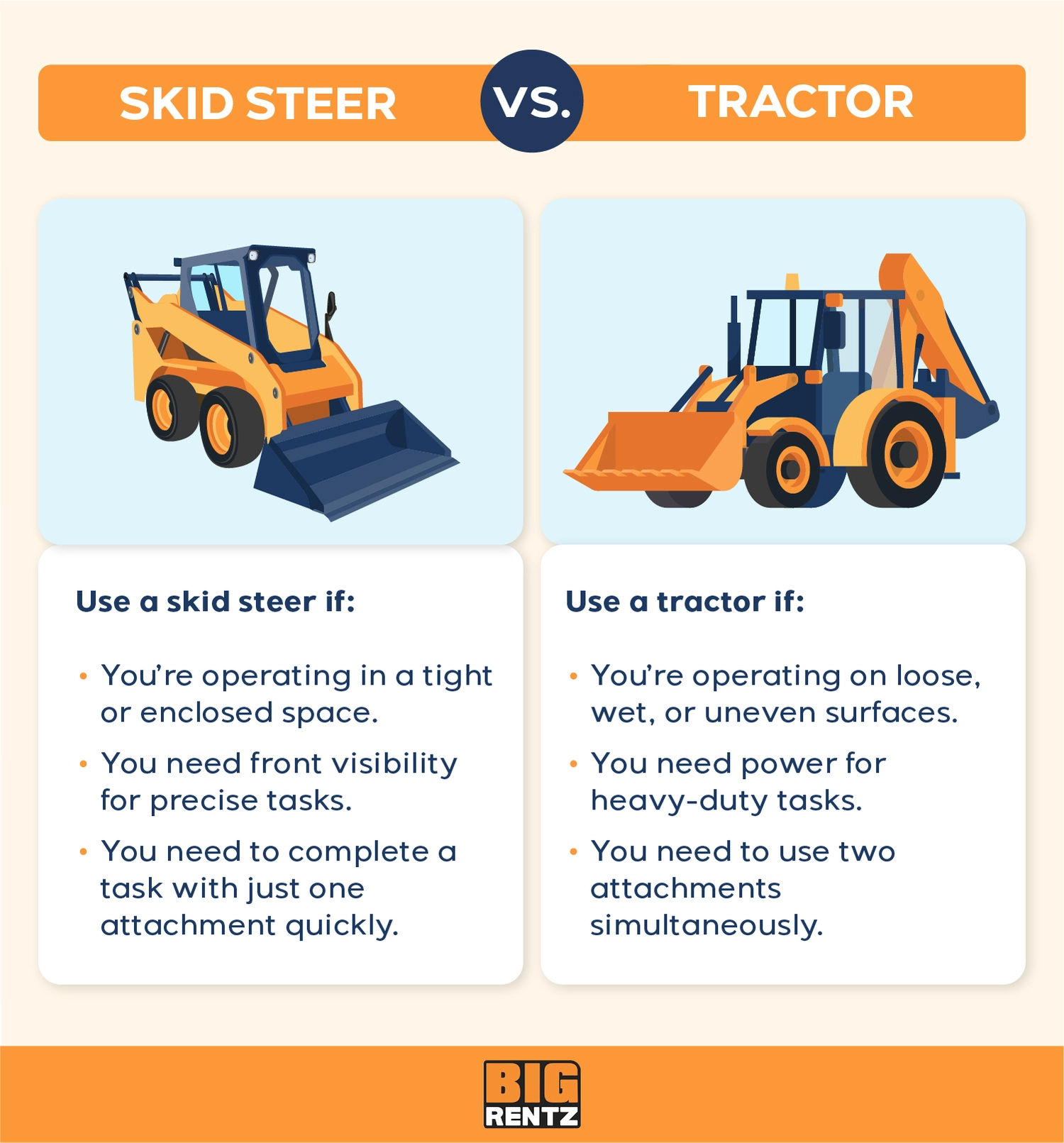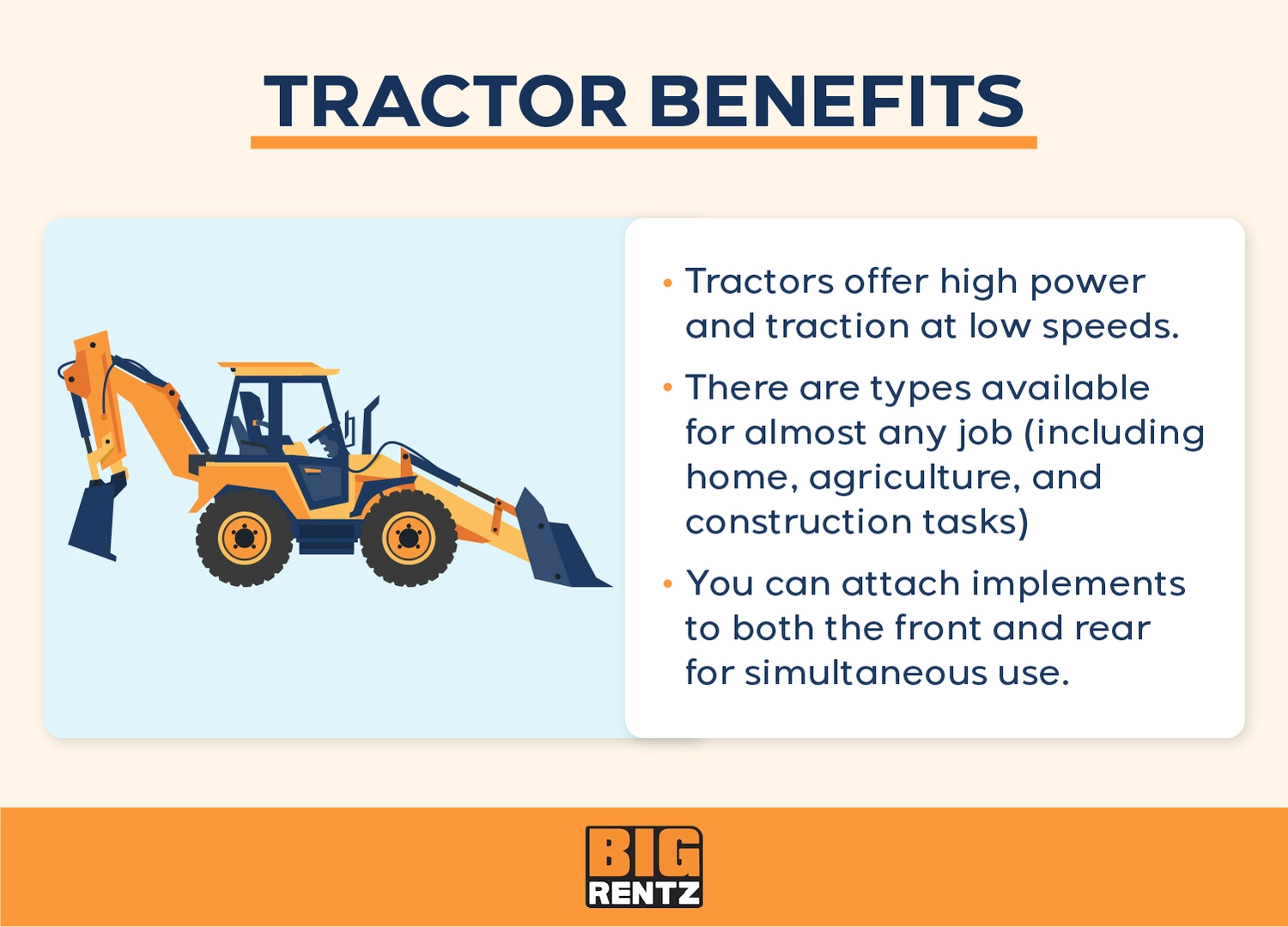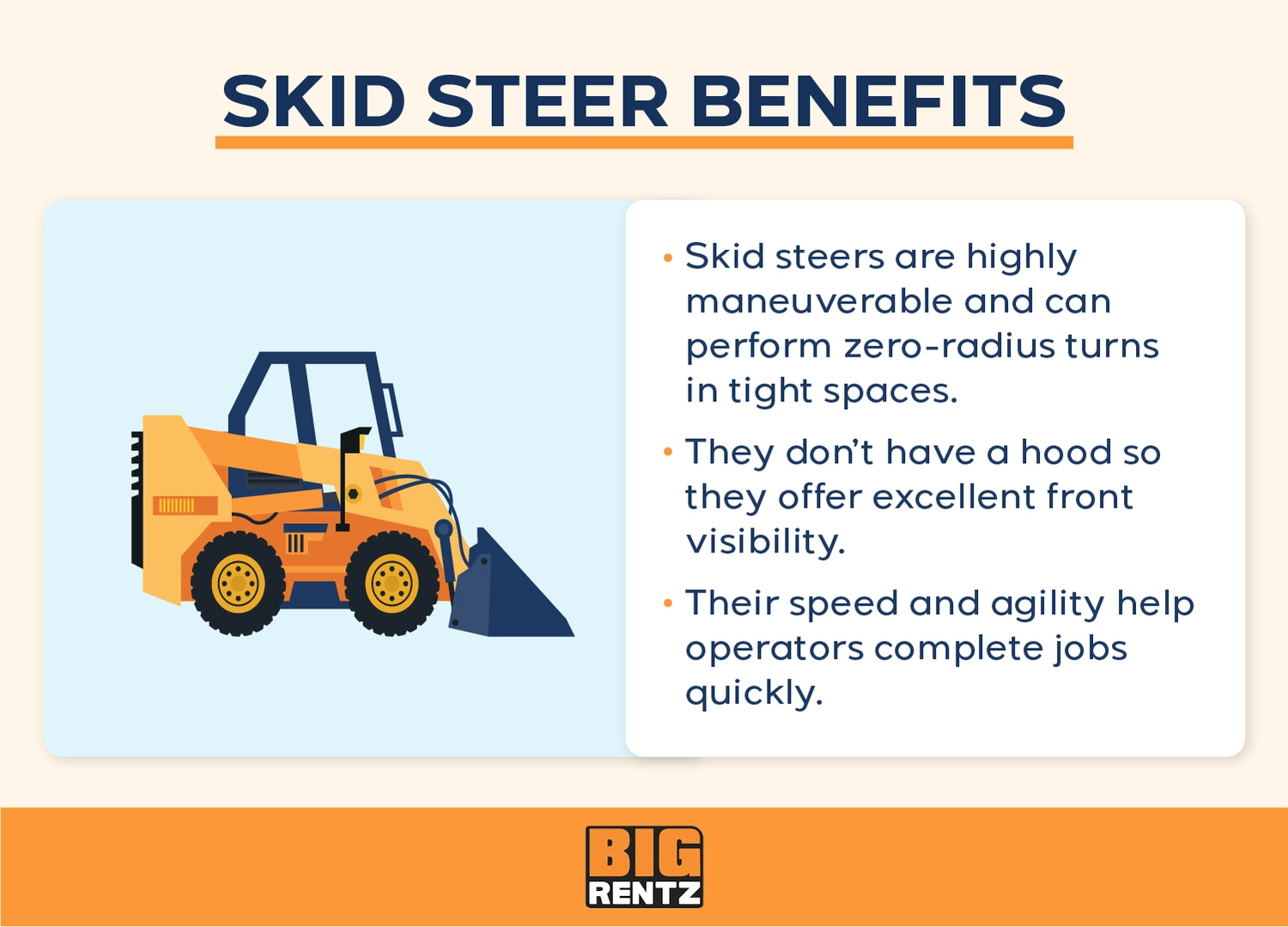Because tractors and skid steers share some common functions, you may have a difficult time deciding which is best for your job. Compact tractors, subcompact tractors, and utility tractors all perform the same tasks as skid steers, and both machines are suitable for construction projects and farming and can be operated by homeowners and landowners. However, while these machines are similar, each has its own unique benefits and uses.
Tractors work well on difficult terrain, can handle heavy-duty tasks, and allow you to use two attachments at once. Skid steers are best for operating precise tasks in small spaces, as they give you better visibility up front compared to tractors and have a tight turning radius.
If you are having trouble choosing between tractors versus skid steers, this post breaks down the benefits and uses of tractors versus skid steers, so you can choose the right one for your next project.
Explore All Skid Steers
Table of Contents
- Skid Steer vs. Tractor
- About Tractors
- About Skid Steers
- How to Choose Which Equipment You Need
- Renting a Tractor or Skid Steer
Skid Steer vs. Tractor (Quick Comparison)
While both machines have a similar scale of adaptability, the benefits and uses of tractors and skid steers differ based on the type of project you need to complete. The chart below provides a quick overview.
| Tractor | Skid Steer | |
|---|---|---|
| Benefits |
|
|
| Uses |
|
|
When to Use a Tractor
While you may only think of tractors as farm equipment, tractors have a lot of power — more than skid steers — making them the better choice for heavy-duty tasks like hauling or digging. They also have larger rear wheels than skid steers, making them the ideal machine to use when operating on loose, wet, or uneven surfaces, and they can be fitted with special tires designed to conquer a specific terrain, making them more stable.
If your project requires the use of multiple attachments simultaneously, a tractor makes the best choice. Unlike skid steers which can only have one attachment, tractor attachments can be fitted on the front and back for two attachments at once. This versatility allows you to move between two tasks without removing the attachments.

When to Use a Skid Steer
Compared to a tractor, a skid steer is the best piece of equipment to operate in tight spaces. It can handle sharp turns and almost rotate in place with more of an unobstructed view. Because skid steers don’t have a hood, you enjoy better visibility when completing a precise task in an enclosed environment. More agile than tractors, you can complete tasks in a skid steer quicker than you can in tractors.
About Tractors
Tractors have large rear wheels that offer you high traction at low speed, so they’re the go-to machine for construction or agricultural projects dealing with uneven terrain. Many types of tractors are designed to complete different tasks. For example:
- Compact tractors are used for landscaping tasks, such as moving mulch or digging post holes, and transporting objects for small land projects
- Sub-compact tractors are used for everyday tasks like mowing lawns and landscaping.
- Utility tractors are used for agricultural hauling, plowing, and fieldwork.

Benefits
There are numerous benefits giving tractors an advantage for certain projects, especially when it comes to construction or agricultural tasks. These include power, types of tractors available, and attachments.
- Power: Compact tractors with under 50 horsepower are available, just like skid steers. However, you can also get utility tractors with 40 to 100+ horsepower for similar tasks that require more power, allowing you more power and versatility for various tasks.
- Various types available: You can buy a tractor for almost any job, whether it be on the farm or construction site. Whether you have industrial projects that require a heavy-duty lift capacity or just need a tractor that can easily drive through rows of an orchard, you can find a specific tractor to fit your needs.
- Simultaneous attachments: You can add attachments to the rear of many tractors. Sometimes, you can have two attachments — one on the front and one on the back. This gives the tractor added functionality.
Uses
Tractors have multiple uses, depending on the job and job site you’re tackling. Here are some routine tasks that tractors carry out.
- Hauling and pulling: Tractors have a variety of attachments that lift and transport materials and heavy equipment across various types of terrain, thanks to their stable framework.
- Clearing land: Because of their horsepower, tractors can clear the land of debris, rocks, or trees with ease. You can also attach a brush cutter to your tractor to quickly rid your area of tall grass and smaller woody elements.
- Snow removal: You can utilize the multiple attachment feature of tractors by using a front-end loader attachment and blade to clear snow.
- Landscaping: Use your tractor to landscape so you can level ground, dig ponds, or till, or you can add a brush cutter attachment to clean out old growth. You can also use it as a mower for both large and small areas. If you come across areas that aren’t smooth and level, the large rear wheels of the tractor will allow it to landscape on uneven or rough terrain.
- Heavy lifting: Tractors use moveable arms and tools for lifting heavy objects. From poles and trees to yards of mulch, gravel, or debris, a tractor can lift and move items easily, and you can attach pallet forks to the front loader for even more lifting tasks.
- Drilling: You can use an auger attachment to drill holes for trees, posts, and signs. The tractor’s horsepower will give you the power needed to drill holes to the right depth.
- Digging: With a backhoe attachment, tractors can turn into powerful excavators for projects involving digging, such as creating foundations, digging pits or drainage canals, and more.
About Skid Steers
Unlike a tractor, a skid steer’s wheels don’t actually turn. You make precise turns by increasing the speed of the wheels on one side, thus making the machine skid and perform zero-radius turns. This makes the skid steer particularly useful for jobs in confined spaces.
Like tractors, skid steers can attach different tools to the front of the machine, and because skid steers come in different sizes, you have one machine that offers many uses for a variety of projects.

Benefits
Just like tractors, skid steers have their own unique set of benefits, and they have the advantage over tractors when it comes to jobs in tight spaces or jobs requiring precision. The benefits include:
- Maneuverability: Skid steers can almost rotate in place and perform sharp, zero-radius turns.
- Visibility: Skid steers don’t have a hood so they offer better visibility when performing sharp turns and using attachments.
- Speed: Skid steers can move quickly, which may allow the operator to complete tasks faster.
Uses
Skid steers have a variety of jobs they can perform, and you will find them especially helpful when you need to move in a small space or complete a precise job. Although the bucket attachment is commonly used and thought of on a skid steer, you can complete a variety of projects using skid steer attachments, including:
- Trenching and digging: You can find a wide variety of attachments for any digging task. Backhoes and augers can be attached to skid steers for digging, and trenchers make easy work when needing to trench out areas for wiring, cables, and more. Powerful wheel saws offer heavy-duty trenching capabilities through hard surfaces, such as cement and asphalt.
- Landscaping: While the trencher is also useful for landscaping, even more attachments expand your capabilities. You can add wood chipper and grinder attachments for forestry and other landscaping jobs and utilize the tree spade to quickly and efficiently dig holes for planting trees. The tiller makes quick work of prepping areas for planting.
- Clearing snow: Like tractors, you can attach a bucket, snow blade, or snow blower to your skid steer to help clear snow.
- Excavating: The same attachments that work for digging can turn your skid steer into an excavator. A ripper can rake out stumps and roots, while your backhoe, trencher, tiller, and wheel saw perform a variety of excavating tasks.
- Construction: You can utilize a cement mixer or pavement miller skid steer for construction and road work tasks. Several attachments can be used to rough grade as well.
How to Choose Which Equipment You Need
When determining whether to use a tractor or a skid steer, consider all the requirements your project has as well as your budget. You might need attachments of a certain kind, and you’ll want to know how large your worksite is and what the terrain is like. Once you have a general idea of what your project entails, you’ll be able to decide which piece of equipment the job requires.
::backdrop{background:rgba(0,0,0,.65)}.cta–dialog[open]{border-width:0;display:flex;flex-direction:column;align-items:center;width:90%;max-width:37.5rem;padding:1.5rem}.cta–dialog[open] .dialog–close{position:absolute;top:1.25rem;right:1.5rem;font-size:30px;line-height:1}.cta–dialog[open] .dialog–header{font-size:1.5rem;font-weight:500;line-height:1.3;text-align:center;margin:1.5rem auto .5rem;padding:1.5rem 0 0}@media (min-width: 768px){.cta–dialog[open] .dialog–header{font-size:2rem;margin:0 0 .5rem;padding:0;text-align:left;width:80%}}.cta–dialog[open] .wrapper–form-illo{display:flex;flex-direction:column;align-items:center;width:100%}@media (min-width: 768px){.cta–dialog[open] .wrapper–form-illo{flex-direction:row;justify-content:center;column-gap:2rem}}.cta–dialog[open] svg{margin-top:.5rem;width:52%;max-width:11.5rem}@media (min-width: 768px){.cta–dialog[open] svg{margin-top:0;max-width:15rem}}@media (min-width: 768px){.cta–dialog[open]{align-items:flex-start}}

×
Download our FREE skid steer rental guide e-book today!
Renting a Tractor or Skid Steer
Once you have decided on a tractor or a skid steer, you can check out the BigRentz equipment rental directory to find a tractor or skid steer that meets your project’s specific requirements.
Explore All Skid Steers